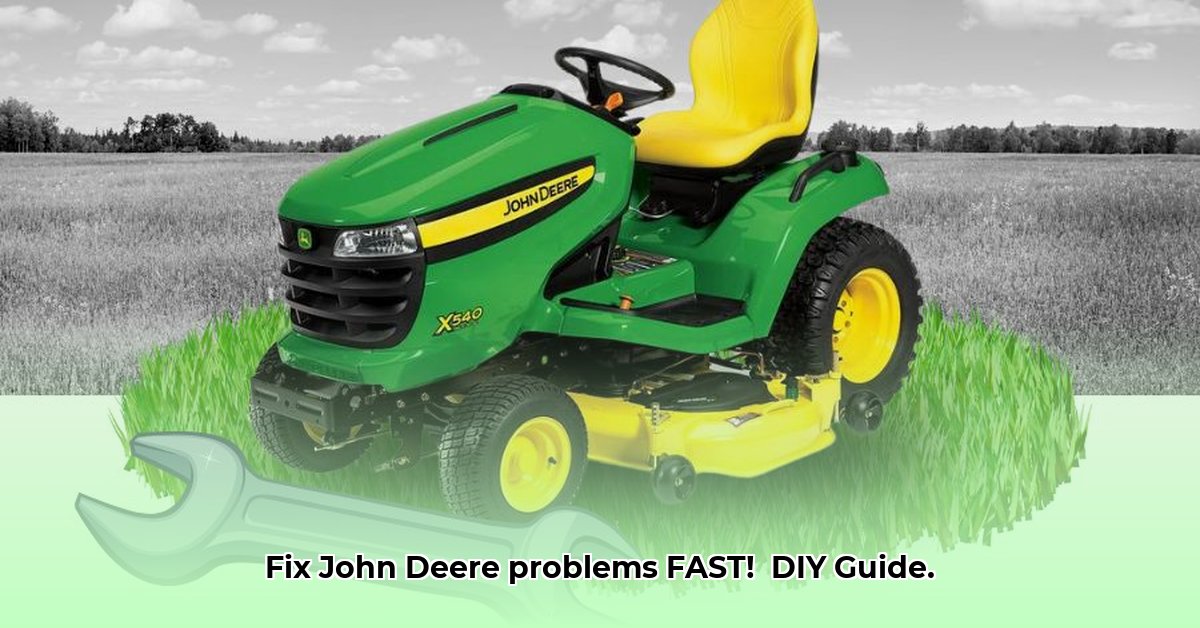
Is your John Deere 100 Series lawn tractor giving you trouble? This comprehensive guide provides step-by-step solutions to common problems, empowering you to get your mower running smoothly again. We'll cover everything from simple starting issues to more complex cutting deck problems, with a focus on practical, actionable advice. Let's get started! For snow removal attachments, check out this helpful guide on John Deere snow blowers.
Starting Troubles: When Your Deere Refuses to Start
A John Deere 100 Series that won't start is frustrating, but often easily resolved. Before calling a repairman, check these key areas:
1. Fuel System Check: Old or contaminated fuel is a common culprit. Does your tractor have enough fresh gasoline? Old gas, especially ethanol blends, can clog fuel lines and prevent the engine from starting.
2. Spark Plug Inspection: The spark plug ignites the fuel-air mixture. Remove the spark plug wire (safety first!), inspect the plug for damage, fouling (carbon buildup), or wear. Replace if necessary. Also check the spark plug wire for cracks or damage.
3. Battery Voltage Test: A weak battery can prevent starting. Use a multimeter to test the battery voltage. If it's low, charge or replace the battery. Clean corroded battery terminals with a wire brush.
4. Safety Switch Verification: John Deere tractors have safety switches (seat, PTO) that must be engaged for the engine to start. Ensure all safety switches are in the correct position. A seemingly minor detail can stop large machinery. Have you checked for safety switch engagement?
Rough Running Engine: A Choppy Ride
A rough-running engine suggests problems with fuel or air delivery. These steps address the most likely causes:
1. Air Filter Examination: A clogged air filter restricts airflow, starving the engine of oxygen. Remove and inspect the air filter; clean or replace it if it's dirty or damaged. This is a quick and easily achievable fix.
2. Fuel Filter Replacement: A clogged fuel filter restricts fuel flow to the engine. Locate and replace the fuel filter; this is a relatively straightforward process.
3. Carburetor Adjustment (Carbureted Models): Carburetor adjustment is more complex and typically requires experience. If you're uncomfortable adjusting the carburetor—and if your model uses one—it is advisable to consult a professional mechanic. Improper adjustment can harm your engine.
Cutting Problems: Uneven Cuts and Other Issues
An uneven cut usually means your blades need attention or your deck is out of alignment.
1. Blade Sharpening: Dull blades tear grass rather than cleanly cutting it. Sharpen or replace your blades – this significantly improves cutting quality.
2. Mowing Deck Leveling: An uneven mowing deck leads to inconsistent cutting height. Refer to your owner's manual for instructions on adjusting the deck leveling screws to ensure even blade height.
3. Blade Balancing: Unbalanced blades cause vibrations that affect cutting quality and can damage the engine. For optimal performance, it is recommended to seek a professional to balance your blades.
Excessive Noise: Listening for Trouble
Unusual noises signal potential problems. Addressing them promptly prevents more significant damage:
- Muffler Issues: A rattling muffler indicates damage or rust. Replace the muffler if necessary. This is a relatively simple replacement.
- Engine Noises (Knocking or Pinging): These sounds often indicate engine wear or low oil. Check your engine oil level immediately; low oil levels cause serious damage.
Preventative Maintenance: Avoiding Future Problems
Regular maintenance is vital for preventing common problems and extend the life of your John Deere 100 Series.
| Maintenance Task | Frequency | Benefits |
|---|---|---|
| Oil Changes | As per manufacturer’s specifications | Ensures proper lubrication and engine longevity. |
| Air Filter Replacement | Regularly (seasonal or more frequently based on usage) | Maintains optimal airflow to the engine. |
| Blade Sharpening/Replacement | As needed, several times per season | Improves cutting quality and reduces engine strain. |
| Fuel System Inspection | Annually or as needed | Prevents fuel system clogs and ensures proper fuel flow. |
When to Call a Professional
While many repairs are DIY-friendly, some issues necessitate professional help:
- Major Engine Problems: Internal engine issues require specialized tools and expertise.
- Complex Electrical Issues: Significant electrical problems are best diagnosed by a qualified technician.
- Hydraulic System Malfunctions: Leaks or malfunctions in the hydraulic system should be handled by a professional mechanic.
This guide provides a starting point for troubleshooting your John Deere 100 Series lawn tractor. Remember to always consult your owner's manual for specific details and safety information before undertaking any repairs. Prioritize safety, always disconnect the spark plug before any engine work!